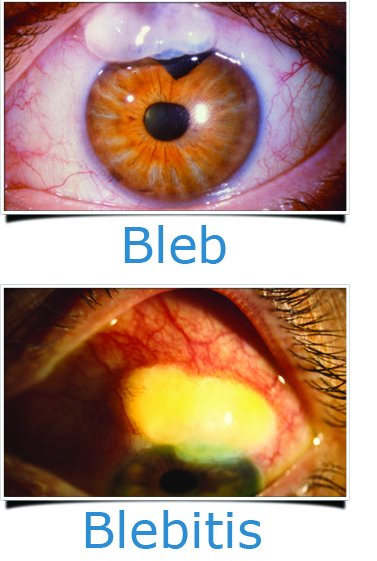 With traditional glaucoma surgery (trabeculectomy), a blister-like fluid collection (called a “bleb”) must be present on the surface of the eye for the surgery to work. Aqueous fluid (the fluid inside the eye) flows through the fistula into this bleb where it then finds its way out of the eye. If this bleb scars down, the the surgery fails and the intraocular pressure (IOP) goes back up potentially causing a further loss of vision from glaucoma. Unfortunately, the body wants to scar down the bleb as part of the natural healing response. In order to prevent this from happening most modern trabeculectomy surgeons use a chemical called an “antimetabolite” to preserve the bleb. The most commonly used antimetabolite (Mitomycin-C, or MMC) causes permanent damage to the eye tissue in the area of the surgery.
With traditional glaucoma surgery (trabeculectomy), a blister-like fluid collection (called a “bleb”) must be present on the surface of the eye for the surgery to work. Aqueous fluid (the fluid inside the eye) flows through the fistula into this bleb where it then finds its way out of the eye. If this bleb scars down, the the surgery fails and the intraocular pressure (IOP) goes back up potentially causing a further loss of vision from glaucoma. Unfortunately, the body wants to scar down the bleb as part of the natural healing response. In order to prevent this from happening most modern trabeculectomy surgeons use a chemical called an “antimetabolite” to preserve the bleb. The most commonly used antimetabolite (Mitomycin-C, or MMC) causes permanent damage to the eye tissue in the area of the surgery.
The tissue exposed to MMC is very fragile and does not heal well. Fluid in the bleb exerts pressure which can result in what is called a “high bleb.” This is essentially a thin bubble-shaped bleb. These can cause (or may exacerbate) Tear Dysfunctional Syndrome resulting in chronic irritation, tearing, and blurred vision. Because the wall of the bleb is so thin any trauma to the eye can rupture it. Since it does not heal well any damage to the bleb may require surgical revision.
Finally, and most concerning, is that when MMC is used during trabeculectomy, there is up to a 5% risk per year of bleb leak{{*}} which can progress to infection of the inside of the eye (endophthalmitis, up to 1% per year) if not successfully treated. Endophthalmitis often leads to severe loss of vision or blindness. This risk continues for the life of the patient unless the bleb scars down (fails).
Canaloplasty is a “blebless” (or bleb-free) procedure. With Canaloplasty no fistulas are created and there is no need to modify the natural healing of the eye. Without a bleb, there is no worsening of Tear Dysfunctional Syndrome or risk of blebitis. Occasionally (about 6% of the time), a bleb will spontaneously form with Canaloplasty. However, because most Canaloplasty surgeons do not use MMC, the bleb is usually “shallow” and unlikely to result in Tear Dysfunctional Syndrome or blebitis.
In The Same Series:
- Trabeculectomy Surgery For Glaucoma
- Why Trabeculectomy is the Most Common Glaucoma Surgery
- Risks of Trabeculectomy (Part 1 of 2)
- Risks of Trabeculectomy (Part 2 of 2)
- When Should Trabeculectomy Be Considered?
Related Articles:
- What Is The Big Deal About A Bleb?
- Is Trabeculectomy an Option After Canaloplasty?
- PhacoCanaloplasty™ vs Phacotrab
- 1 in 5 Trabeculectomy Patients May End up With Ptosis (Eyelid Droop)
- Trabeculectomy versus Canaloplasty (TVC study)
- Trabeculectomy Glaucoma Surgery After Canaloplasty
- Trabeculectomy Glaucoma Surgery (Part 3 of 12 of “What’s New In Glaucoma Surgery” Presentation)


